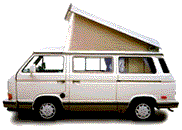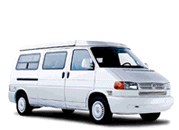Date: Fri, 3 Nov 1995 14:17:06 +0100 (MET)
Sender: Vanagon Mailing List <vanagon@vanagon.com>
From: darie@hasler.ascom.ch (Darie Duclos)
Subject: SUMMARY: pilot bearing
This letter is long overdue and I'd better write it before
I forget what went on.
SYMPTOMS: Difficulty getting into 2nd gear, then 1st, then
3rd and 4th. Almost impossible (for me who has no
practice) to get into any gear in the end. Had to
start the car in 1st to get going at all and skip
straight to 3rd in order to get home. The whole
thing went from nothing wrong to not being able to
shift within 3-4 hours, but note that this is in
the Swiss mountainous terrain.
Clutch had prefectly good resistence so we assumed
the hydraulic system was ok
Trying to shift into reverse while standing still
and after giving a little gas caused a grinding noise.
i.e. should be the clutch and not the synchronizers.
Reverse is not synchronized so had it worked fine,
synchronizers would have been suspicious.
The clutch lever moved nicely up and down while
someone pressed the clutch pedal, so attachments
to the hydraulic system seemed in order. Had to
be .. inside.. (shudder).
DIAGNOSIS:Given all of the above symptoms, Vanagon experts from
the list correctly diagnosed the problem as a broken
(mangled up) pilot bearing. Judging from the number of
Vanagon owners on this list who've had to make the repair,
this is a common problem.
DESCR: The pilot bearing is a small "tube" about 5/8" (1.5cm)
long and 1/2" in diameter. Your pinky fits in it snug.
Inside the "tube" are tiny metal "sticks" lined up
next to each other around the inside perimeter. The
flywheel has a hole in its center about the size and
length of your index finger (approx. ok?) The pilot
bearing is inserted into this hole *very* snuggly but
not far in. The hardest part of the repair is usually
to get the old one out.
REPAIR: It was not necessary to take out the engine to do this
repair, but since my suspension is low in the back, I
prefered to jack up the van a bit to be able to move during
all that time I spent underneath it. I didn't put it up
too high since I'd have a longer way to go when lowering
the transmission. I put (European) cinder blocks underneath
the engine. (Throughout the process of removing the tranny,
the height of the blocks had to be adjusted several times.
If they are too low, the engine never reaches them; if they
are too high, i.e. too close up to the engine, then the
tranny can't come down enough to clear the metal plate in
front of it as you try to pull it forward off the engine-
tranny mounting bolts. My book says that there should be
12cm, 4 3/4", between the engine and the blocks, but I didn't
measure what we ended up leaving.)
CV joint removal
As strongly recommended by Tim, we tried to remove all 12
bolts holding the CV joints to the tranny. Apparently, these
bolts are usually 12-point (this means a star with 12 points,
I thought it was a size or something) 8mm. Apparently, not
a lot of companies make a ratchet piece of this type, and
one company which makes a very good one is Hazett. Tim stronly
recommends getting this tool if your bolts are of this type.
My bolts are 6mm hex. All but 2 came out. Luckily the 2 are
on the same side so that we could completely detach at least
one CV joint from the tranny. I tied the CV joint up and out
of my face.
Dropping the transmission
I happened to find a small hydraulic jack on sale at a local
hardware store and it was very useful. Tim says you can
use a trolley or skateboard, a scissor type jack and some wood
blocks. We put the jack underneath the tranny and lifted just
enough to take up the weight. I removed the transmission ground
strap (twisted metal cable up at the front of the tranny,
bolted to the tranny and the car body), the starter cables, the
gear shift connectors (2 bolts holding the gear shaft, a long
rod running down the length of the car in the middle) and
disconnected the accelerator cable in back above the engine
as it looked like it was running through something that was
attached to the tranny. I removed the nut off the big bolt
that sticks through a rubber thing and hold the front of the
transmission up. I removed the 2 bolts holding the top of
the transmission and engine together (one also goes through
the starter) and the nuts on the 2 bolts at the bottom.
I went back underneath to remove the bolt holding up the front
of the tranny up. We lowered the transmission with the jack
until the engine was resting on the cinder blocks under it.
Then we wiggled the transmission off the remaining bottom
mounting bolts, lowering a little and wiggling back a little,
and so on. Look out for big rubber pipes above the transmission
getting hooked on it and making you life more difficult.
Finding the center of gravity of the tranny is not easy and
we had to hook the front back up and move the jack several
times to get it right so that we wouldn't risk damaging the
input shaft when the tranny finally came off.
Changing clutch parts
We could not roll the transmission clear out of the way since
we still had a CV joint hooked up to it, but we managed to
shove it to one side enough to be able to reach into the
clutch area. We took the clutch plate off the flywheel (damn
that things is heavy when you're jammed between the tire
the engine and the transmission!), threw away the old clutch
disk. Sticking my little finger into the flywheel I could
clean out all sort of little spaghetti-like metal bits coming
from the pilot bearing. We were relieved to see that the
diagnosis about the pilot bearing sounded right.
Removing the pilot bearing case
We tried and tried to pull the pilot bearing out. We built
a puller as suggested by filing down 2 sides of a washer and
putting it on a bolt, toggling it into the pilot bearing and
standing it back up in back of the bearing, then passing the
end of the bolt that was still sticking out through a metal
bar and adding a washer and a nut. We thought that tightening
the nut would eventually pull out the pilot bearing. It
didn't. We bent the first 2 washers. The 3rd one was thicker
and bigger. On this attempt, we stripped the nut we were
turning. Finally, we decided to remove the flywheel. We had
had conflicting reports as to whether this was necessary,
but in my opinion it was. The bearing could not get by a
lip in the hole of the flywheel.
Then my husband went to a local garage and borrowed a puller!
Wish we'd thought of this earlier.. The puller looked like
it was going to break, but it managed to get the pilot bearing
out without breaking.
Reassembling it all
After carefully tapping in the new pilot bearing by setting a
socket piece the same size on it and tapping with a rubber
hammer, we filled it packed with high-temperature grease.
We put the flywheel back on, put the new clutch disk in and
held it centered with a borrowed clutch-centering tool while
we put the clutch plate back in place. We took the opportunity
to change the throw-out bearing too. It's a round thing about
the size of a hockey puck that attaches onto the input shaft.
It's on the transmission side when you pull it away.
Getting the transmission back on wasn't totally easy. I had to
lie on my back under the car with my head towards the front
of the car and my feet against the front end of the transmission
doing the rumba while my husband directed the back end of
the tranny onto the mounting bolts.
ACKNOWLEDGEMENTS
I have to thank in particular Tim Smith who gave such excellent descriptions
of all procedures, tools, and useful things to do at the same time. Thanks
also to Bradley, Jim Bryant, Joel Walker, Harvey Chao, John Foster, Kelley,
Gerald and David Schwarze for all sorts of great tips.
\/\/\/\/\/\/\/\/\/\/\/\/\/\/\/\/\/\/\/\/\/\/\/\/\/\/\/\/\/\/\/\/\/
/ Darie Duclos, '86 Westy / "All my life I've wanted to be \
\ Unix Systems Infrastructure \ somebody. It's only now I see /
/ Ascom Hasler AG / I should have been more \
\ Bern, Switzerland \ specific." /
/ Darie@hasler.ascom.ch / -- Lily Tomlin \
\/\/\/\/\/\/\/\/\/\/\/\/\/\/\/\/\/\/\/\/\/\/\/\/\/\/\/\/\/\/\/\/\/
| 
